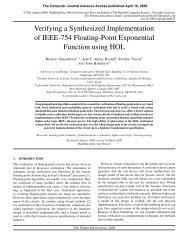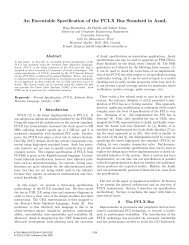PDF File - Hardware Verification Group - Concordia University
PDF File - Hardware Verification Group - Concordia University
PDF File - Hardware Verification Group - Concordia University
Create successful ePaper yourself
Turn your PDF publications into a flip-book with our unique Google optimized e-Paper software.
•Both procedural and declarative semantics - Designs can be described in <strong>Hardware</strong>C<br />
either as a sequence of operations and/or as a structural interconnection of components.<br />
•Processes and interprocess communication - <strong>Hardware</strong>C models hardware as a set of<br />
concurrent processes that interact with each other through either port passing or message<br />
passing mechanisms. This permits the modeling of concurrency at the functional<br />
level.<br />
•Unbound and bound calls - An unbound call invokes the functionality corresponding<br />
to a called model. In addition, <strong>Hardware</strong>C supports bound call that allows the<br />
designer to constrain the implementation by explicitly specifying the particular<br />
instance of the called model used to implement the call, i.e. bind the call to an<br />
instance.<br />
•Template models - <strong>Hardware</strong>C allows a single description to be used for a group of<br />
similar behaviors through the use of template models. A template model is a model<br />
that takes in addition to its formal parameters one or more integer parameters, e.g. an<br />
adder template that describes all adders of any given size.<br />
•Varying degrees of parallelism - For imperative semantic models, <strong>Hardware</strong>C offers<br />
the designer the ability to adjust the degree of parallelism in a given design through<br />
the use of sequential ([ ]), data-parallel (f g), and parallel (< >) groupings of operations.<br />
•Constraint specification - Timing constraints are supported through tagging of statements,<br />
where lower and upper bounds are imposed on the time separation between<br />
the tags. Resource constraints limit the number and binding of operations to<br />
resources in the final implementation.<br />
As any real system a SoC is no more than a number of entities and objects interacting<br />
together. This is the reason for the limitation of the C-based proposals. By reference to<br />
software design, languages that can be used at the system level have to be preferably<br />
object-oriented. This is the reason why nowadays more mature proposals are based on<br />
C++. In this report we will discuss mainly two C++ based proposals: Cynlib and SystemC.<br />
3.3.1.3. Cynlib<br />
Cynlib provides the vocabulary for hardware modeling in C++. It is a set of C++ classes<br />
which implement many of the features found in the Verilog and VHDL hardware description<br />
languages. It is considered as a "Verilog-dialect" of C++, but it is more correct to say<br />
that it is a class library that implements many of the Verilog semantic features. The purpose<br />
of this library is to create a C++ environment in which both hardware and testing<br />
environment can be modeled and simulated [10].<br />
Cynlib supports the development of hardware in a C/C++ environment. To do this, Cynlib<br />
extends the capabilities of C/C++ by supplying the following features, Concurrent Execution<br />
Model, Cycle-Based, Modules, Ports, Threads, Deferred Assignments, Two-state data<br />
values, Multiple clocks and Debugging support.<br />
10





